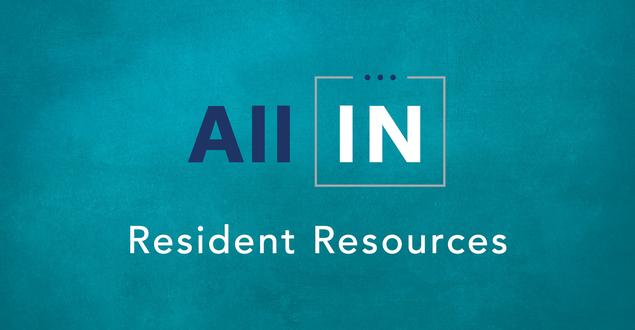
COVID-19 has impacted nearly every aspect of the local and global economy. This page was compiled of internal and external sources to provide insight about the pandemic as well as its impact on capital markets, rent collection, construction and architecture, operations, public policy, among other impacts.
Rent Collections
Dominium Rent Collection Report: Through April 26, 2020 we have collected 91.9% of anticipated rent. This is down by (1%) when compared to February and March collections. We conservatively estimate that month end collections will be 92.5%, down from previous months total collections.

Previous Dominium Rent Reports can be found here on DominiumApartments.com/All-In.
Dominium has been collecting information on April Rent Collections from others, which is summarized in the two charts here.
NMHC has been tracking rent collections industry-wide and hosted a webinar on 4/22 to discuss their ongoing findings, why multifamily housing has been a relatively resilient industry and how to maintain that going forward in the COVID-19 Pandemic.
NMHC Rent Payment Tracker Finds Rent Payment Rate at 95% of Prior Month
They also report encouraging rent receipts for the month of April as reported in their tracker.
NMHC Rent Payment Tracker 4.19
Housing & Employment News
Novogradac: LIHTC Equity Market Moving Forward Cautiously In Light of COVID-19 Pandemic
Novogradac notes that deals are still closing with original pricing and terms at present and April rent collections are fairing better than originally anticipated. LIHTC transactions are continuing to close amid this crisis.
Novogradac: 2020 HUD Limits for DOM
HUD published the 2020 HUD Program Limits and Multifamily Tax Subsidy Project Income Limits on March 31, 2020. This document provides calculations income limit maps discussed in a recent webinar.
Northmarq: COVID-19 Special Report
Northmarq’s report discusses measures taken by the Federal Reserve in response to COVID-19, as well as remarking on impacts of unemployment on the multifamily market. Rent collections were stronger than anticipated, but they note that continued monitoring is necessary as this crisis evolves.
GMHF: COVID-19 Tenant & Rental Property Impacts
Greater Minnesota Housing Fund surveyed affordable rental housing owners to ascertain how COVID-19 has impacted their renters’ ability to pay April rents.
RCLCO Real Estate Advisors sent out a survey to gather how real estate market professionals thought about the condition of the market.
The City of Minneapolis has established Minneapolis Gap Funding allocating more than $5 million to Minneapolis residents and businesses. Emergency Housing Assistance Program will provide up to $2,000 per household depending on size to help with rent payment, utility payments and other housing stability related costs.
Cushman Wakefield Multifamily Investor Webinar April 2020
Cushman Wakefield’s recent webinar provided a good overview of the current economic climate and the policies decisions to address it, along with potential impacts across asset classes. Key takeaways include a projected sharp decline in GDP in Q2 and potentially drawn out recovery, but that multifamily housing rental income is resilient, in part because of policies that are supportive to renters.
CBRE Multifamily Finance Update
CBRE’s Multifamily Finance Update remarks on trends that are occurring in the 6th week of the coronavirus downturn, including rent retention, rent declines, and slowing leasing activity.
Below are links to affordable housing-relevant webinars discussing COVID-19’s impact on the industry, as well as Dominium’s notes, taken by Mark Lambing, who participated in each:
- 4/1/2020 Novoradac COVID-19 Webinar
- Link to Novogradac Notes
- 4/2/2020 CITI COVID-19 Webinar
- Link to Webinar Replay
- Link To Coronavirus Impact Slides
- Link to Presentation Slides
- 4/2/2020 Freddie Mac TEL Select Sponsor
- Link to Presentation
- 4/8/2020 Freddie Mac TEL Select Sponsor
- Link to Presentation
- 4/15/2020 Jeffries Municipal TEL Select Sponsor
- Link to Presentation
Pandemic News
The CDC’s tracker of confirmed cases of and deaths from COVID-19 across the US provides the most up to date information on the spread of the virus.
IHME’s COVID-19 Projections page shows trends and projections of deaths and hospital resource usage.
13.9% of New Yorkers Test Positive For Coronavirus Antibodies – Still Not Enough to Foster Herd Immunity
In a recent study, outlined here in Forbe’s, the percentage of New Yorkers who tested positive is 10 times higher than the presumed infection rate. However, this is not nearly enough to develop herd immunity, which happens when over 60% of the population has been exposed and developed antibodies.
Coronavirus antibody testing shows LA County outbreak is up to 55 times bigger than reported cases
A CNBC report indicates that antibody testing in Los Angeles County reveals that COVID-19 is more widespread, between 28 and 55 times higher than the confirmed cases. This emerging information would decrease the fatality rate in Los Angeles County.
Three articles from The New York Times provide a wealth of data on the Coronavirus:
This long-form article discusses the epidemiology of COVID-19 and it’s impacts. NY Times: The Coronavirus in America: The Year Ahead
This comprehensive list of statistics of confirmed cases and deaths that illustrate which US cities have the worst outbreaks now, where more outbreaks might appear, and where the virus may be decreasing its spread. NY Times: Five Ways to Follow the Coronavirus Outbreak for Any Metro Area in the US
And finally, this article outlining Italy’s nationwide lockdown that went into effect on March 10th and how it led to a dramatic drop in ICU patients, potentially providing an example for other countries to slow the spread of the virus.
Harvard Business Review discusses how digital contact tracing has slowed the COVID-19 spread in East Asia. They explain different applications that have been developed over the years to trace movements of people who have tested positive for diseases. Although, these apps may be working to trace infection, they also raise questions about privacy and data sovereignty.
Economic News
CBRE: Q1 2020 US Retail Figures
CBRE provides Q1 Retail Data and summarizes the abrupt impacts of COVID-19 on retail sales and consumer sentiment in March, as well as the implications for Retail real estate.
Key Bank Economic Update 4.20.2020
This Key Bank overview of economic forecasts for Q2 2020 projects increased unemployment claims, a more severe drop in GDP than previously projected, driven by both increased cuts to nonessential businesses and reduced demand from consumers.
The Washington Post reports that Global markets showed signs of rebounding on Wednesday following days of plummeting oil prices. Prices rebounded from $0 a barrel to around $14 to $20 a barrel. Due to nearly half the world’s population sequestered by some form of stay-at-home orders, demand for oil dropped, but with the announcements of loosening restrictions and reopening economies, demand will normalize.
Bloomberg: Masked Lawmakers to Vote in Person to Pass $484 Billion Stimulus
Bloomberg notes that The House of Representatives voted—in person, wearing masks—on April 23 on a deficit spending bill which would fund forgivable loans to small businesses, small and medium banks and credit unions, as well as funding for hospitals and testing.
Auto news source, Jalopnik, reports that like other industries affected by stay-at-home orders and sweeping unemployment, the used car market is also experiencing pricing issues as vehicle sales fell 63% compared to the same time last year.
As the CDC has urged American to avoid nonessential travel during the COVID-19 pandemic, causing flights to be between 5 to 15% occupied. As reported on VOX news service, only slightly more than 124,000 passengers have passed through TSA checkpoints on April 2nd compared to 2,411,500 travelers on April 2nd of last year.
Other Interesting & Helpful Resources
Deloitte: The World Remade by COVID-19
The Deloitte report projects four possible scenarios of how the next 3-5 years will play out as the global community and economy respond to and recover from COVID-19 and its impacts. These scenarios are primarily based on five fundamental uncertainties: Severity of the pandemic, Level of Collaboration, Health Care System, Economic Consequences, and Social Cohesion.
Cushman Wakefield: Recovery Readiness: A How-to Guide to Reopening your Workplace
Cushman Wakefield provides this guide for business owners looking to address the challenges COVID-19 has created as they open up their offices.
MSPBJ: The ABCs of PPP–For Businesses, a Tangled Lifeline
The Minneapolis/St. Paul Business Journal writes about the Small Business Administration’s relief program and how that money is trickling into Minnesota. As the money is administered by banks, only banks that process SBA 7(a) loans are a part of the Paycheck Protection Program. Currently, nearly a total of 33,819 Minnesota businesses have been approved for a PPP loan.
MSPBJ: Want in on Round Two of the PPP Loans? Bankers share their advice
In a follow up article on the PPP Loans, The Minneapolis/St. Paul Business Journal received advice from several local bankers, encouraging those that could not participate in the last round of loans to apply now and if a business’s bank is not participating in the program to ask for a referral to another bank.
State-by-State Actions
- Schools: Education Week
- Stay at Home/Shelter in Place: The New York Times
- Construction Limits: Architect Magazine

Resident Resources
IRS Information on COVID-19 Checks
Dominium Resident Resources by property
Information on filing for unemployment
Communications
We hope that our friends and partners in affordable housing find this information helpful and will send other information our way as well. A collection of all previous updates can be found below:
April 1, 2020 - Impact Update #1
April 2, 2020 - Impact Update #2
April 3, 2020 - Impact Update #3
April 4, 2020 - Impact Update #4
April 6, 2020 - Impact Update #5
April 7, 2020 - Impact Update #6
April 8, 2020 - Impact Update #7
April 9, 2020 - Impact Update #8
April 10, 2020 - Impact Update #9
April 14, 2020 - Impact Update #10
![]()
